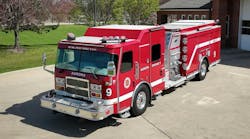Download the full PDF of the supplement here.
Fire apparatus design varies around the world. Understanding how designs were developed to meet solutions for different countries and their operations can provide useful insights for an apparatus design committee making critical decisions about apparatus design. Here we’ll review some of the differences between North American and European apparatus design so as to better understand the “why” behind these evolutions and how they can be applied in the design process.
Cabs and chassis
When it comes to cabs and chassis, consumers in the North American fire apparatus market have many more choices than anywhere else in the world. In fact, it is estimated that in North America, 60–70 percent of all major fire trucks sold are built with custom chassis. Specialty manufacturers offer short cabs, medium cabs, long cabs, raised-roof designs, and many alternative configurations. The interior of these machines can be specified by many manufacturers to be upholstered “heavy duty,” with exposed metal surfaces or any combination in between.
Outside North America, there are very few custom fire apparatus chassis and cabs. Chassis and cabs are constructed specifically or exclusively for vocational application. More specifically, most chassis and cabs for major firefighting apparatus are what could be defined as “commercially available trucks” adapted for fire apparatus use. In this style of manufacturing, the vehicle starts with basic chassis and cabin, which can be modified and adapted for the fire service organization. This tradition has given the North American market a different evolutionary path than comparative markets.
The European evolution to this style of apparatus is a design solution to many countries in Europe having domestic chassis manufacturers within their country that are popular and easily serviced. Certain fire departments will favor local brands, such as Iveco in Italy, Renault in France, Mercedes in Germany, Scania in Sweden, and so on. Many larger European builders will offer their up-fits and body work across many chassis styles and brands, yet there remain imbedded regional producers that will specialize in a specific country with a locally favored brand that is designed specifically for that area.
For decades, European commercial cabs have benefitted from being crash-tested and certified. The European design preference uses a commercial chassis, which offers a safety advantage. This testing eventually made its way to North America through global chassis builders, and after some time, it migrated to fire apparatus cabs. It was many years between the adoption of the standard in Europe and being used on North American fire truck cabs.
Specialized cab manufacturers add crew seating and additional space to these commercial cabs in some applications. Crew seating at the front of the bodywork is also popular in European design, which creates a similar crew environment to North American custom cab crew areas. Thus with the acceptance of nationally recognized vehicle standards—as opposed to the country-by-country standards often seen in Europe—North America has become a unique location for the growth of the specialized fire apparatus market. This simple truth drives many of the visual distinctions between North American apparatus and those from other parts of the world.
The standard that drives much of North American design—NFPA 1901—covers a broad area and guides the consumers and manufacturers into a market that’s driven by standards but that still allows for customization within the tolerances of those written recommendations. In Europe, standards and requirements can vary from country to country, which affects the design of firefighting vehicles in smaller regional markets.
One example involves some safety-driven cultural design requirement in Europe. In both the United Kingdom and the Netherlands, the fire apparatus design for major vehicles seeks to minimize operating firefighters from climbing on the apparatus (other than getting into and out of the cabin). As a result, the North American-style hosebeds, upper coffin compartments and body designs evolved differently in the context of reduced climbing risk. In these designs developed to minimize climbing, the attack lines and supply hose are stowed in lower positions and carried within the lower bodywork. Long tools and ladders are mounted to be safely deployed from the ground or accessed with rack systems.
Equipment and pump systems
The design of equipment deployments and pump operations has also evolved differently between North American and European products. North American design, in many cases, reveals preplanning of hose loads and an emphasis on rapid deployment upon arrival. By contrast, most global design vehicles favor an “enclosed transit” design where the hoses and firefighting equipment are mounted and stowed within the vehicle.
In terms of pumping and design, we see that engine output power in global designs is typically matched to the pump performance requirements. In Europe, the relative energy (horsepower/hp) to drive the pump determines the engine and chassis component combinations to be used. The firefighter often stays very close to that minimum requirement. In contrast, in the North American market, we see a large pool (20–25 percent) of fire apparatus with high horsepower and large transmissions that greatly exceed the minimum power requirements to have the pump perform as expected.
By design, a European pumper is typically a rear-mounted (pedestal-style) pump with a minimum number of discharge valves (two to four) in an operation where the pump operator sets the pump pressure and then adjusts each discharge with "turn-down" valves. North American vehicles can have 7 to 14 different discharge valves, each purchased under the guise of "what if …?,” whereas the European concept is a blank pump with hoses rolled and stowed in the exterior lower compartments, which is then set up on site to handle that specific evolution. The North American model is based on pre-connected lines; the global design is more a stowed and set-up-as-needed design.
Ladders and platforms
Regarding aerials and platforms, standards and performance expectations have sent the designs in slightly different directions. Europe prefers a tighter package for a 100-foot (32-m) aerial. Conceptually, the smaller (maneuverable) package turn-table ladders with limited ground ladders and increased truck-mounted "below-grade" performance capabilities serve the environment of the European operations.
In North America, the standards and recommendations applied to similar 100-foot (32-m) products typically focuses on larger apparatus, as we carry more ladders, equipment and tools. Much of the explanation of the North American design is rooted in the 115-foot minimum ground ladders (per NFPA 1901, 8.8.1.2). North American designs stabilize and level the aerial via the base vehicle, whereas many European-designed units stabilize via the frame but level via the device itself. The term “rescue aerial” is prevalent in the European design process.
North American ground ladder-carrying requirements make the domestic aerial truck body a larger and higher box, which limits below-grade performance of the aerial device. The European "rescue aerial" expectations have evolved to create a device that sets up and levels quickly, and can raise, retract and extend at a fast pace to evacuate victims
Platform design has evolved in North America to hold significant weight at the tip and provide breathing air, power, scene lights, dual monitors and tools in the basket to be a working platform. Once again, we see that the expectation of a complement of ground ladders drives the body design. In Europe, the ground ladders are not designed into the aerial and platform as is so common in North America.
Additionally, weight capacities, water flow requirements and ancillary tool stowage reveals the differences in design. Many of these differences are in response to the operating environment in which the apparatus will be placed. European platforms commonly have articulation capabilities in the fly section to get over parapets. The popularity of various articulation designs makes the egress access ladder found in North American standards a bit difficult to design. Many North American platform designs with full use ladders become much larger and heavier than their European counterparts.
Ideas and lessons
The operating environment and design theory of European fire apparatus may be different than that of North American apparatus, but there is much to be learned from both industries. Components like shutter doors, Storz connections, large-diameter hose, compressed air foam systems (CAFS) and many other components have migrated to become truly global designs.
Perhaps the most important lesson is to study and understand the theory behind any good design. Fire apparatus are evolving and continue to do so every year. Globally, there are many approaches to safety. The lessons of safety applied to design should resonate to fire apparatus designers.
Innovation in the world of fire apparatus is a truly global endeavor.






